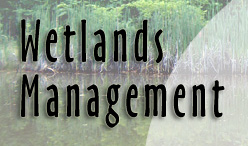A
number of mammals occur in wetlands including large
mammals such as moose and black bears or small
rodents like bog lemmings or water shrews. However,
the most recognized mammals in wetlands include many
of the medium-sized fur-bearing species such as
beaver, muskrat, mink, and otter. All of these
wetland-dependent species, as well as raccoons,
which commonly use wetlands, are important in the
fur industry. A couple of these species, including
beaver and muskrat, are important in shaping,
changing, and creating wetlands. For example, beaver
create dams on streams, which results in the
creation of additional wetlands acreage. Muskrats
harvest emergent vegetation such as cattails for
their huts or for food, thus creating openings, in
emergent wetlands, which allows waterfowl to use
them.
Although fewer people trap furbearers today than
historically, there are still a number of trappers
who spend considerable time pursuing, fur-bearing
mammals. Trapping is highly regulated and can
provide wildlife managers with important information
regarding population size, relative ecosystem
health, and disease distribution. The primary reason
people trap is for recreation and to earn a few
dollars. Furs are used for making coats and other
clothing due to the insulating and water repelling
qualities.
For more information on wetland-dependent mammals
and mammals that use wetlands click on the following
links.

Click here to see an
exotic nutria.
 |

